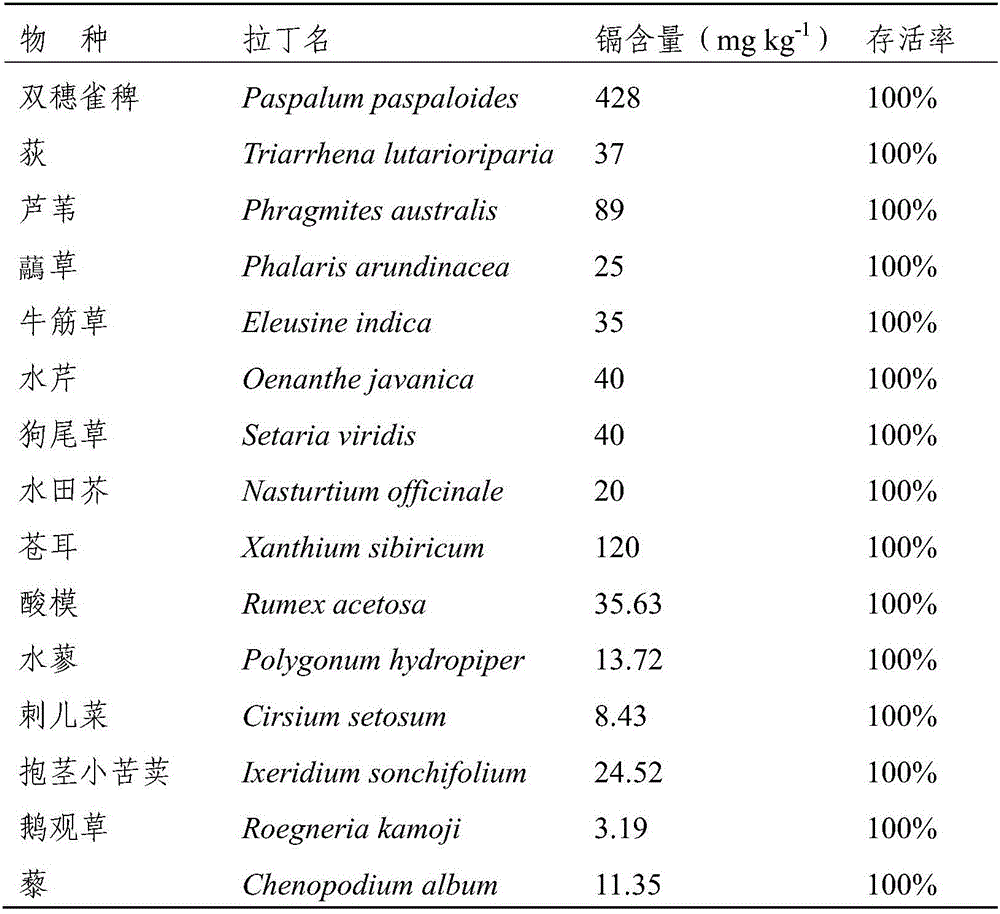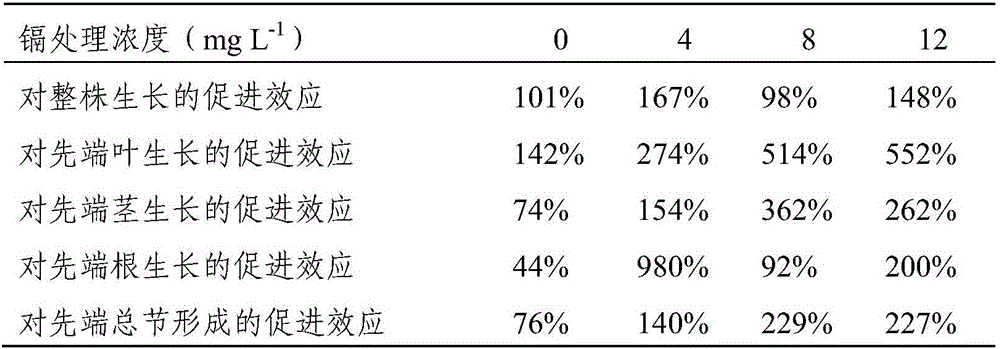Method for remediating heavy metal cadmium contaminated water by using clonality of wetland clone plant
A technology for cadmium pollution and heavy metals, applied in the field of environmental ecology, can solve problems such as unsatisfactory restoration results, and achieve the effects of restoring and protecting river ecology and service functions, improving ecological environment, and beautifying landscapes
- Summary
- Abstract
- Description
- Claims
- Application Information
AI Technical Summary
Problems solved by technology
Method used
Image
Examples
experiment example 1
[0030] Experimental Example 1 Determination of target species
[0031] Through greenhouse control experiments, a wetland plant with strong tolerance and enrichment ability to the heavy metal cadmium in water was screened out, and the species could spread and multiply rapidly in the shallow water area of the river (lake) bank. We collected a total of 15 species of native wetland plants with wide natural distribution in typical wetlands in Beijing (Beisha River, Miyun Reservoir, Jinniu Lake, etc.), brought them back to the greenhouse for cultivation, and artificially added cadmium solution (4 mg L -1 ) for 1 month. After treatment, the survival rate of each species was recorded, and the cadmium enrichment in the aerial parts of the plants was determined.
[0032] Experimental results: as shown in Table 1. Paspalum chinensis, cocklebur, reed, cress, foxtail, Digi, sorrel, oxtenoid, etc. have higher enrichment amounts of cadmium, and at low concentrations (4 mg L -1) under ca...
experiment example 2
[0037] We further carried out the following greenhouse experiments to answer the three key questions in "Example 1" through reasonable experimental design and accurate experimental analysis. The specific experimental steps are as follows:
[0038] (1) intercepting the branches formed by clonal plant Paspalum bisplenica through asexual reproduction, and adopting the method of layering to cultivate, cultivate 8 mature nodes and the stolon fragments of the young apex, so that each mature node grows roots ;
[0039] (2) Construction of a net-type floating bed: Use ordinary fishing nets (mesh type: 6 strands of 2 cm) as the floating bed net, the floating bed frame is composed of rigid pvc pipes with a hole diameter of 1 cm, hollow and sealed, and each floating bed unit is 32 × 20 cm long. In practical large-area applications, the four corners of the bed should be fixed with a sealed hollow plastic floating box, and the floating box should be fixed on the shore pile;
[0040] (3) ...
Embodiment 1
[0063] Simulation of remediation of cadmium-contaminated wastewater discharged from industry. Use CdCl 2The solution is configured with industrial wastewater, and the industrial wastewater is isolated into a wastewater pool, where the concentration of cadmium is 4 mg L -1 .
[0064] Make the cloned plant Paspalum chinensis cultivated to produce a large number of branches through asexual reproduction; cut off the branches, and carry out layering planting on the pond bank of the waste water pond with a plant spacing of 15cm, until it grows 20 cm on the pond bank. The stolon fragments of each mature node and the young apex, after each mature node grows roots and forms a network structure, guide the plant apex to crawl to the water surface of the waste pool, and construct a net floating bed on the water surface: use ordinary fishing nets (mesh type : 6 strands of 2 cm) as a floating bed net, the floating bed frame is composed of rigid pvc pipes, hollow and sealed. Make the plan...
PUM
 Login to View More
Login to View More Abstract
Description
Claims
Application Information
 Login to View More
Login to View More - R&D
- Intellectual Property
- Life Sciences
- Materials
- Tech Scout
- Unparalleled Data Quality
- Higher Quality Content
- 60% Fewer Hallucinations
Browse by: Latest US Patents, China's latest patents, Technical Efficacy Thesaurus, Application Domain, Technology Topic, Popular Technical Reports.
© 2025 PatSnap. All rights reserved.Legal|Privacy policy|Modern Slavery Act Transparency Statement|Sitemap|About US| Contact US: help@patsnap.com



